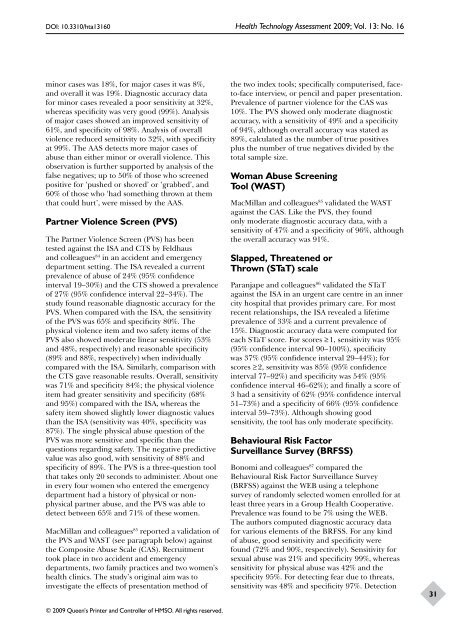How far does screening women for domestic (partner) - NIHR Health ...
How far does screening women for domestic (partner) - NIHR Health ...
How far does screening women for domestic (partner) - NIHR Health ...
You also want an ePaper? Increase the reach of your titles
YUMPU automatically turns print PDFs into web optimized ePapers that Google loves.
DOI: 10.3310/hta13160 <strong>Health</strong> Technology Assessment 2009; Vol. 13: No. 16<br />
minor cases was 18%, <strong>for</strong> major cases it was 8%,<br />
and overall it was 19%. Diagnostic accuracy data<br />
<strong>for</strong> minor cases revealed a poor sensitivity at 32%,<br />
whereas specificity was very good (99%). Analysis<br />
of major cases showed an improved sensitivity of<br />
61%, and specificity of 98%. Analysis of overall<br />
violence reduced sensitivity to 32%, with specificity<br />
at 99%. The AAS detects more major cases of<br />
abuse than either minor or overall violence. This<br />
observation is further supported by analysis of the<br />
false negatives; up to 50% of those who screened<br />
positive <strong>for</strong> ‘pushed or shoved’ or ‘grabbed’, and<br />
60% of those who ‘had something thrown at them<br />
that could hurt’, were missed by the AAS.<br />
Partner Violence Screen (PVS)<br />
The Partner Violence Screen (PVS) has been<br />
tested against the ISA and CTS by Feldhaus<br />
and colleagues 84 in an accident and emergency<br />
department setting. The ISA revealed a current<br />
prevalence of abuse of 24% (95% confidence<br />
interval 19–30%) and the CTS showed a prevalence<br />
of 27% (95% confidence interval 22–34%). The<br />
study found reasonable diagnostic accuracy <strong>for</strong> the<br />
PVS. When compared with the ISA, the sensitivity<br />
of the PVS was 65% and specificity 80%. The<br />
physical violence item and two safety items of the<br />
PVS also showed moderate linear sensitivity (53%<br />
and 48%, respectively) and reasonable specificity<br />
(89% and 88%, respectively) when individually<br />
compared with the ISA. Similarly, comparison with<br />
the CTS gave reasonable results. Overall, sensitivity<br />
was 71% and specificity 84%; the physical violence<br />
item had greater sensitivity and specificity (68%<br />
and 95%) compared with the ISA, whereas the<br />
safety item showed slightly lower diagnostic values<br />
than the ISA (sensitivity was 40%, specificity was<br />
87%). The single physical abuse question of the<br />
PVS was more sensitive and specific than the<br />
questions regarding safety. The negative predictive<br />
value was also good, with sensitivity of 88% and<br />
specificity of 89%. The PVS is a three-question tool<br />
that takes only 20 seconds to administer. About one<br />
in every four <strong>women</strong> who entered the emergency<br />
department had a history of physical or nonphysical<br />
<strong>partner</strong> abuse, and the PVS was able to<br />
detect between 65% and 71% of these <strong>women</strong>.<br />
MacMillan and colleagues 85 reported a validation of<br />
the PVS and WAST (see paragraph below) against<br />
the Composite Abuse Scale (CAS). Recruitment<br />
took place in two accident and emergency<br />
departments, two family practices and two <strong>women</strong>’s<br />
health clinics. The study’s original aim was to<br />
investigate the effects of presentation method of<br />
© 2009 Queen’s Printer and Controller of HMSO. All rights reserved.<br />
the two index tools; specifically computerised, faceto-face<br />
interview, or pencil and paper presentation.<br />
Prevalence of <strong>partner</strong> violence <strong>for</strong> the CAS was<br />
10%. The PVS showed only moderate diagnostic<br />
accuracy, with a sensitivity of 49% and a specificity<br />
of 94%, although overall accuracy was stated as<br />
89%, calculated as the number of true positives<br />
plus the number of true negatives divided by the<br />
total sample size.<br />
Woman Abuse Screening<br />
Tool (WAST)<br />
MacMillan and colleagues 85 validated the WAST<br />
against the CAS. Like the PVS, they found<br />
only moderate diagnostic accuracy data, with a<br />
sensitivity of 47% and a specificity of 96%, although<br />
the overall accuracy was 91%.<br />
Slapped, Threatened or<br />
Thrown (STaT) scale<br />
Paranjape and colleagues 86 validated the STaT<br />
against the ISA in an urgent care centre in an inner<br />
city hospital that provides primary care. For most<br />
recent relationships, the ISA revealed a lifetime<br />
prevalence of 33% and a current prevalence of<br />
15%. Diagnostic accuracy data were computed <strong>for</strong><br />
each STaT score. For scores ≥ 1, sensitivity was 95%<br />
(95% confidence interval 90–100%), specificity<br />
was 37% (95% confidence interval 29–44%); <strong>for</strong><br />
scores ≥ 2, sensitivity was 85% (95% confidence<br />
interval 77–92%) and specificity was 54% (95%<br />
confidence interval 46–62%); and finally a score of<br />
3 had a sensitivity of 62% (95% confidence interval<br />
51–73%) and a specificity of 66% (95% confidence<br />
interval 59–73%). Although showing good<br />
sensitivity, the tool has only moderate specificity.<br />
Behavioural Risk Factor<br />
Surveillance Survey (BRFSS)<br />
Bonomi and colleagues 87 compared the<br />
Behavioural Risk Factor Surveillance Survey<br />
(BRFSS) against the WEB using a telephone<br />
survey of randomly selected <strong>women</strong> enrolled <strong>for</strong> at<br />
least three years in a Group <strong>Health</strong> Cooperative.<br />
Prevalence was found to be 7% using the WEB.<br />
The authors computed diagnostic accuracy data<br />
<strong>for</strong> various elements of the BRFSS. For any kind<br />
of abuse, good sensitivity and specificity were<br />
found (72% and 90%, respectively). Sensitivity <strong>for</strong><br />
sexual abuse was 21% and specificity 99%, whereas<br />
sensitivity <strong>for</strong> physical abuse was 42% and the<br />
specificity 95%. For detecting fear due to threats,<br />
sensitivity was 48% and specificity 97%. Detection<br />
31
















